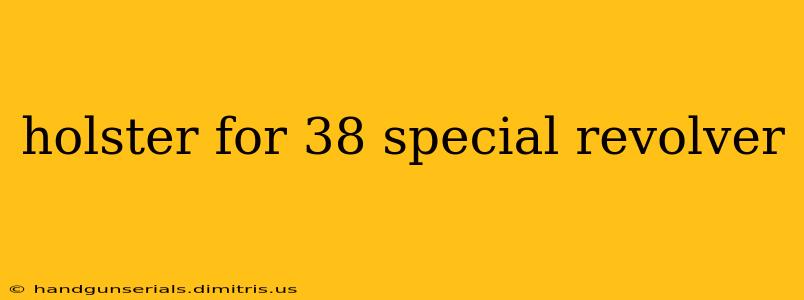Finding the perfect holster for your .38 Special revolver is crucial for safety, comfort, and ease of access. With a wide variety of options available, understanding your needs and the different holster types is essential before making a purchase. This guide will walk you through the key considerations to help you choose the best holster for your .38 Special.
Understanding Your Needs: Concealed Carry vs. Open Carry
Before diving into the types of holsters, consider how you intend to carry your .38 Special revolver. This significantly impacts your holster choice:
-
Concealed Carry: This requires a holster that's designed to hide your firearm discreetly under clothing. Factors like size, comfort, and retention are paramount. Popular choices include inside-the-waistband (IWB) and pocket holsters.
-
Open Carry: This involves openly displaying your firearm. While comfort is still important, the primary focus shifts to security and ease of access. Outside-the-waistband (OWB) holsters are common choices for open carry.
Types of Holsters for .38 Special Revolvers
Numerous holster types cater to different carrying preferences and firearm styles. Here's a breakdown:
1. Inside-the-Waistband (IWB) Holsters:
- Pros: Excellent for concealed carry, comfortable for everyday wear, allows for a variety of carry positions (appendix, waistband, etc.).
- Cons: Requires proper fitting and adjustment for optimal comfort and concealment. May be less accessible than OWB holsters.
- Best for: Individuals prioritizing concealment and comfortable all-day carry.
2. Outside-the-Waistband (OWB) Holsters:
- Pros: Easy access, secure retention, suitable for open carry, more holster options available.
- Cons: Less concealment than IWB holsters, may be bulky and uncomfortable for extended periods.
- Best for: Individuals prioritizing quick access and open carry situations.
3. Pocket Holsters:
- Pros: Excellent for deep concealment, easy to use with smaller revolvers.
- Cons: Can be bulky in pockets, less secure retention than other holster types, may print if the pocket is thin.
- Best for: Individuals carrying smaller .38 Special revolvers and prioritizing deep concealment.
4. Shoulder Holsters:
- Pros: Good for concealment, distributes weight evenly.
- Cons: Can be uncomfortable for extended periods, can be bulky under clothing.
- Best for: Individuals who prioritize concealed carry and even weight distribution.
5. Ankle Holsters:
- Pros: Deep concealment, suitable for backup guns.
- Cons: Limited accessibility, uncomfortable for extended periods, can hinder mobility.
- Best for: Individuals needing a backup gun with deep concealment as a priority.
Material Considerations: Leather vs. Kydex
The material of your holster significantly impacts its durability, comfort, and retention:
-
Leather Holsters: Known for their comfort, breathability, and ability to mold to the firearm over time. However, they are often more expensive and require more maintenance.
-
Kydex Holsters: Extremely durable, resistant to moisture and temperature changes, and offer superior retention. They are typically less expensive than leather holsters but can be less comfortable against the skin.
Key Features to Consider
Regardless of the holster type, consider these features:
- Retention: A secure holster prevents accidental discharge. Look for adjustable retention features for optimal safety.
- Comfort: A comfortable holster is essential for all-day carry. Consider materials, shape, and size.
- Concealability: If concealed carry is your goal, choose a holster designed for your body type and clothing.
- Accessibility: Balance ease of access with security when choosing a holster.
Conclusion: Finding Your Perfect Fit
Choosing the right holster for your .38 Special revolver is a personal decision. Consider your carrying style, needs, and preferences when making your choice. Prioritize safety, comfort, and ease of access to find the holster that best suits your individual requirements. Remember to always practice safe gun handling techniques.

